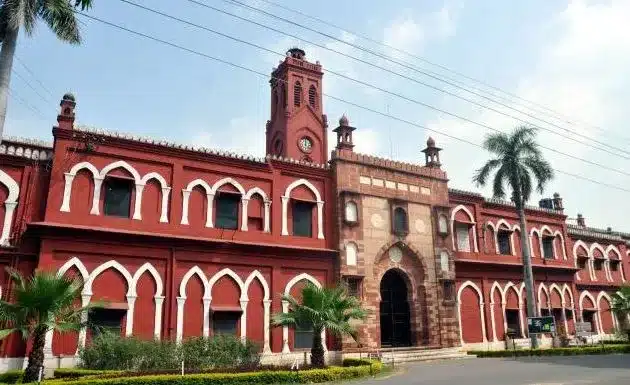What’s in today’s article?
- Why in News?
- Article 30 of the Indian Constitution
- Background of the Controversy around AMU’s Minority Status
- What Minority Status Entails for AMU?
- Arguments from the Centre and AMU
- Conclusion
Why in News?
A Bench headed by the CJI will deliver its verdict (on CJI’s last working day in office) on whether Aligarh Muslim University (AMU) can claim minority status under Article 30 of the Indian Constitution.
Article 30 of the Indian Constitution:
- It consists of provisions that safeguard various rights of the minority community in the country keeping in mind the principle of equality as well.
- Article 30(1) says that all minorities, whether based on religion or language, shall have the right to establish and administer educational institutions of their choice.
- Article 30(1A) deals with the fixation of the amount for acquisition of property of any educational institution established by minority groups.
- Article 30(2) states that the government should not discriminate against any educational institution on the ground that it is under the management of a minority, while giving aid.
Background of the Controversy around AMU’s Minority Status:
- It originated in 1967 when the Supreme Court (SC) ruled on challenges to amendments to the university’s founding Act, arguing that they stripped the Muslim community of the right to administer the institution.
- In 1951, non-Muslims were allowed to join the University Court (the supreme governing body at the time), and the Visitor – a role held by the President of India, replaced the university’s Lord Rector.
- In 1965, the Executive Council’s powers were expanded, diminishing the University Court’s authority.
- The SC concluded that AMU was not established by the Muslim minority but by an Act of Parliament (Aligarh Muslim University Act, 1920).
- This judgement, known as the S. Azeez Basha vs. Union of India case, held that AMU lacked minority institution status.
- In 1981, the government amended the AMU Act to assert that the institution was created by the Muslim community to advance their cultural and educational goals.
- However, the Allahabad HC struck down both this amendment and AMU’s 50% Muslim reservation in 2006, reaffirming the Azeez Basha ruling.
- The issue was then referred to a larger bench and decision follows years of legal debates and a seven-judge bench led by CJI reserving its judgement in February
- The upcoming judgement will determine if Azeez Basha will be overturned.
What Minority Status Entails for AMU?
- Article 15(5) of the Constitution exempts minority educational institutions from reserving seats for Scheduled Castes (SCs) and Scheduled Tribes (STs).
- Since AMU’s minority status is sub judice, and the SC directed in 2006 that status quo be maintained, the university does not have SC/ST quotas.
- If the SC declares AMU a minority institution:
- AMU would not have to reserve seats for SC/ST/OBC/EWS groups but could reserve seats for Muslims, potentially up to 50% or more.
- The university’s administrative structure would shift from its current setup, which includes a diverse Executive Council, and it would have a separate admissions process.
Arguments from the Centre and AMU:
- The St. Stephen’s college precedent: The SC had previously recognised the minority status of Delhi’s St. Stephen’s College in 1992, affirming its right to admit Christian students up to 50% and administer itself autonomously.
- The centre’s argument:
- The Centre distinguished St. Stephen’s from AMU, noting that the former was founded privately, while AMU was created by an Act of Parliament and continuously receives government funding.
- The Centre argued that AMU, as a national institution, should uphold its secular foundations and not prioritise one community’s interests.
- Counter arguments:
- AMU contended that exempting it from certain quotas does not harm public interest, as Article 30 provides minorities with special rights.
- Senior advocate Kapil Sibal argued –
- That minority rights contribute to societal equality by balancing the needs of diverse social sections.
- That (according to the St. Stephen’s ruling) minority communities have a “continuing right to administer” institutions they establish, irrespective of government involvement.
- Senior advocate Rajeev Dhavan pointed to institutions like Aliah University in Kolkata, which retain minority status despite government funding.
Conclusion:
- The SC’s upcoming decision will be pivotal for AMU, determining whether it can claim minority status and retain autonomy over its admissions and governance under Article 30.
- This verdict will also impact minority educational institutions’ rights and their relationship with state policies on social justice and equality.
Q.1. What is Article 29 of the Indian Constitution?
According to Article 29, any section of the citizens residing in the territory of India or any part thereof having a distinct language, script or culture of its own shall have the right to conserve the same.
Q.2. What is the Supreme Court of India’s verdict in the TMA Pai Foundation case of 2002?
For the purpose of Article 30, who are religious or linguistic minority, the Court held that it would be determined on the basis of their numbers in a State or Union Territory and not in the country.
News: CJI Chandrachud’s last working day: Is AMU a minority institution? 7-judge bench to rule today | IE
Last updated on June, 2025
→ UPSC Notification 2025 was released on 22nd January 2025.
→ UPSC Prelims Result 2025 is out now for the CSE held on 25 May 2025.
→ UPSC Prelims Question Paper 2025 and Unofficial Prelims Answer Key 2025 are available now.
→ UPSC Calendar 2026 is released on 15th May, 2025.
→ The UPSC Vacancy 2025 were released 1129, out of which 979 were for UPSC CSE and remaining 150 are for UPSC IFoS.
→ UPSC Mains 2025 will be conducted on 22nd August 2025.
→ UPSC Prelims 2026 will be conducted on 24th May, 2026 & UPSC Mains 2026 will be conducted on 21st August 2026.
→ The UPSC Selection Process is of 3 stages-Prelims, Mains and Interview.
→ UPSC Result 2024 is released with latest UPSC Marksheet 2024. Check Now!
→ UPSC Toppers List 2024 is released now. Shakti Dubey is UPSC AIR 1 2024 Topper.
→ Also check Best IAS Coaching in Delhi
























